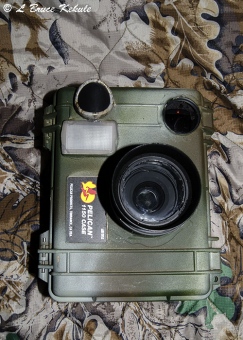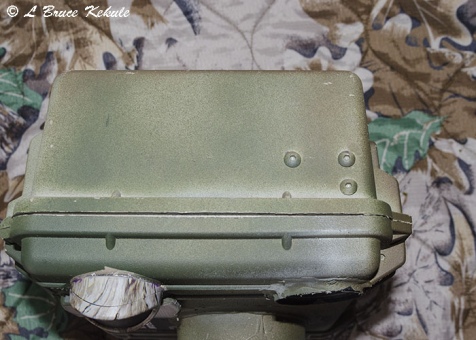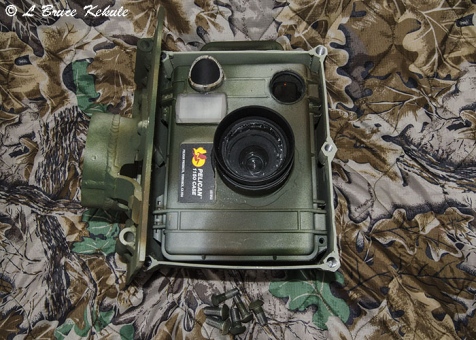Nikon D300s trail cam: A multi-purpose DSLR
A camera trap with two sensors and two flash systems
A Nikon D300s trail cam in a Pelican 1150.
My latest cam is probably the most versatile DSLR trail cam I have built so far specifically put together for the varied conditions and camera trap setups found in Thai forests. With fantastic opportunities for the big cats, wild cattle and other amazing creatures, I decided to build this unit for several reasons.
My choice of a Nikon D300s was three-fold: I found one in used condition at a fair price. I already had a Nikon ML-3 ‘Modulite Remote Control’ trigger that works with the Nikon D200 up to the D800 plus the pro-size Nikon bodies with the 10-pin plug. The D300s is a medium sized camera that just fits in a Pelican 1150 case that I also had. I prefer this size for most of my DSLR trail cams.
The Pelican 1150 opened showing internal components.
Another motive for the D300s was its ability to produce very little noise at high ISO settings. The cam has a Nikon ‘DX’ fixed 35mm ƒ1.8 lens and uses a MB-D10 battery grip with two EN-EL3e batteries. I will be starting out with ISO 400 and if I get too many dark daytime images, will go up a notch or two and probably stay at 800.
This unit has two sensors: the active infrared ML-3 and a passive infrared Snapshot Sniper SSII board that can be easily switched from one to the other. A special aluminum holder was made-up for the ML-3 receiver attached to the case with three 8/32” button head machine screws at the top on the right. The SSII was placed on the left over the flash.
The top end showing three screws holding the ML-3 receiver.
The ML-3 transmitter is housed in an ‘elephant proof’ aluminum box and has 10mm pivot bolts and L-plates. A laser pointer fits in the tube at the top to help in alignment and the box is adjustable for all angles. A 10mm ‘Python’ locking cable 10mm runs through a pipe welded to the faceplate.
ML-3 transmitter with the ‘laser pointer’ in an ‘elephant proof’ aluminum box.
There are two flash systems: a Nikon SB-400 with two AA externals and SC-17 sync cable (shortened) to fit upside-down next to the cam on the left, and to fire off on every shot tripping a Nikon SB-80 with two 4-pack AA externals (either new Eneloop or AA Lithium) with the flash set to remote. An ‘elephant proof’ box houses the SB-80 and battery packs with stainless steel 10mm pivot bolts, nuts, lock washers and L-plates and is adjustable for most angles. Another ‘Python’ cable secures the flash.
Slave flashes to be used with the D300s; Nikon SB-80 (right)
and National’ generic slave flash (left).
The other system is a PT-04NE FM Radio Speedlite trigger (transmitter and a couple receivers) mounted to an SB-80 and a SB-28 as slaves. I will explain my reason below for the ‘two in one’ system on both the sensors and flash. Another slave flash was built using a ‘National’ generic flash with two 2-pack AA externals for a total of eight AA batteries. A ‘Nissin’ flash trigger I had for more than a decade and recently found along with a ‘National’ sync cable to control the flash, works very well. This all fits nicely in a clear Pelican 1030 and I built my ‘elephant proof’ box as shown that is also adjustable.
Unfortunately, the Nikon ‘wireless flash system’ using the pop-up flash is not viable because the cam will only fire once (even in continuous mode) and then wait a second or two before tripping again. I need multiple shots in continuous mode (5-6 shots) to catch quick stepping animals more than once. The Nikon SB-600, 700, 800 or 900 can be tripped with the pop-up flash (line-of-sight) but it’s just too slow for this cam.
The reason I’m using a SB-400 is simple; it will fire on the first trigger and follow-up shots specially with AA Lithium batteries. It also has loads of power (better than the flip-up) to fill the frame and is TTL. A few remote slaves strategically placed will reduce ‘eye-shine’. I have made up a simple mirror system to direct light straight into the flash sensor as an experiment.
Experimental mirror to be angled directing light into the flash sensor
and attached to the tree above the flash unit.
The camera was a tight fit actually expanding the case a bit but after some serious sanding with a drum sander on both the case and cam, it now slips down nicely to the bottom and it closes easily. The sides of the case are slightly thinner but will not be a problem. However, a notch had to be cut for the shutter cable but that’s all.
The snorkel is thin aluminum tubing with a 77mm UV filter. The flash hole is covered with a shortened Nikon diffuser and the ‘ML-3 receiver’ is covered by a 40.5mm UV filter on the right, and the SSII and HPWA are fitted on the left. Marine ‘Goop’ is used on all ports.
D300s trail cam in an ‘elephant proof’ aluminum box.
As usual, an elephant proof box was made up for the cam to just fit and is installed on a tree using four 3” x 3/8” stainless lag bolts from inside the box. Four 12mm socket and two 10mm ‘power torque’ machines screws attach the faceplate and two 10mm (3/8”) ‘Python locking cables’ slip through pipes welded to the front for extra security. Camouflage paint in my usual ‘no two alike’ pattern. I will also be using dried moss glued on to the faceplate and sides of the box. Plastic leaves are wrapped around the box and locking cables to conceal everything.
The reason for the ‘two in one’ system: When there is heavy insect activity during the rainy season (now), large beetles, butterflies and moths will trip an active infrared sensor shooting an empty forest. I would use the passive infrared during this time. But during the dry season and for exact tripping, the ML-3 active infrared is more precise.
On the flash: some setups that can use light sensitive slave flashes, the SB-400 would be activated. Others sites that would require radio transmitted flash control due to tree or root placement, the radio trigger would be used. I can be selective on both systems and everything stays in the 1150.
I really look forward to setting this cam and will post the first set-up when done. Hope this helps those with ‘DSLR’ madness (like me). Just kidding…! Enjoy.








